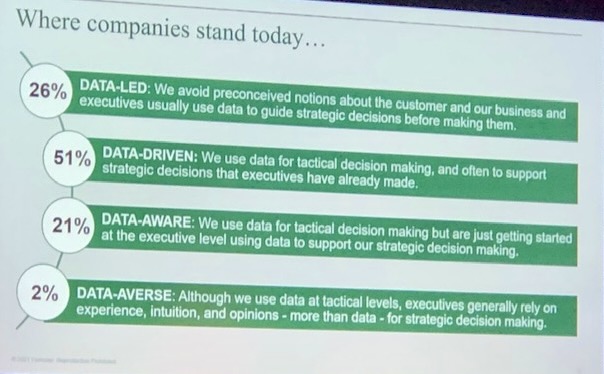
How is Your Company Data Defined?
Companies like data – they love it – but their relationships with it can be pretty complicated. For one thing, lots of companies gather data without mapping out the paths to their end games, or data goals. And for another, many organizational leaders don’t treat their data relationship, like all relationships, as fluid.
Forrester defines data relationships in four stages, from data-averse to data-led. It’s a highly instructive and useful guide. It’s also a build, advancing from the least data-defined to the most data-defined companies.
All organizational leaders should know these stages, and revisit them regularly to (honestly) assess the stage where they operate, and where they should be.
How Close are You to the Data Finish Line? 4 Steps
Forrester surveyed business leaders to learn how many operate in each of the four data-defined stages. Brendan Witcher, vice president and principal analyst of Digital Business Strategy at Forrester, presented the results at the CMRC retail conference in September.
Following are the results. For each stage, I offer my own experience-based tips to determine which types of loyalty initiatives fit with each, where they should be and how to tell when they are ready to advance to the next step.
Phase 1: Data-Averse (2% of companies): These companies use data at tactical levels, but their executives generally rely on experience, intuition and options more than on data for strategic decision-making.
What companies should be in this stage? Generally, this is prominent among private, family-run businesses, where “tribal knowledge” and gut-feel are valued barometers. But being small and private does not bar a company from being data-aware. Look around. Independent shops use Square to process transactions (and therefore manage data). The technology is available and affordable. Given how quickly companies are progressing, this is a risky place to be. Companies that remain in this phase are stuck in the Data Dark Ages.
When is it time to move on? Three key events can trigger a data-averse company to embrace data: it is going public, it is changing ownership/management, or it is preparing for the next generation of family leadership.
Phase 2: Data-Aware (21% of companies): Organizations in this stage tend to use data for tactical decision-making – such as when to initiate certain sales and marketing campaigns. They are just embarking on using data to support strategic decision-making at the executive level.
What companies should be in this stage? Typically, data-aware organizations invest a lot of resources in collecting data and mining its insights. It’s a necessary step to customer understanding, but myopic, according to Forrester. This is where video gaming company GameStop headed after I joined in 2009. I was told that GameStop had no data, but that wasn’t the case. It was just “data ignorant.” I took the existing data sources (the Game Informer magazine subscription data, game reservation data, ecommerce transactions, real estate info, email list, etc.) and cobbled together a Swiss cheese database. Lots of holes. But it sustained us until we launched PowerUp Rewards the following year.
When is it time to move on? Any organization that strives to master a level of personalized, relevant marketing or a customer-relationship management (CRM) strategy, has to move up. Here’s a pro tip to getting there: Focus on information collected directly from members (first-party data); or data that members intentionally and proactively share with you (zero-party data).
Phase 3: Data-Driven (51% of companies): These companies use data for tactical decision-making, and often to support (i.e., justify) strategic decisions that executives have already made. This is where companies, paraphrasing Witcher, weaponize data to reinforce what’s already been decided.
What companies should be in this stage? I suspect most companies reside in this stage. Here, tribal knowledge still abounds and is taken into account on decision-making. The risk is that being data-driven often entails a look-back strategy: “Hey, how did that campaign do?” “What are the demographics of the respondents?” or, “How many people in the database purchased in the past 90 days?”
When is it time to move on? Simply put, when a company wants to move beyond its “investor call” data, it is ready to step up. Uber, which offers the Uber Rewards program with its multitude of options – food delivery, rides, etc. – has been described as “data-driven,” but I think it’s on its way to the next stage. This is due to its confluence of location-based data, shopper-based data (through food delivery) and reward membership shared data.
Phase 4: Data-Led (26% of companies): Organizations at this stage avoid pre-conceived notions about their customers and business. Their executives typically turn to their data to inform them before making strategic decisions.
What companies should be in this stage? The companies at the top of the data-climb are cutting-edge and use data to leapfrog their competition. Their leadership teams likely include Data Czars (chief data officers) who give their analytics staffs planned time to go down a rabbit hole. This is how relevant insights typically spring forth, vs. using analytics teams to churn out reports on what has happened. These companies, such as Delta Air Lines, actively use machine learning and artificial intelligence in meaningful ways.
When is it time to move on? Unfortunately, I don’t see many companies in this phase, as it requires a big analytics staff and a robust, cared-for, hygiene’d database. Nevertheless, stay tuned: New technologies and more-specialized third-party experts are elevating data and its functions continuously.
Wherever You Are, Ask: How Can We Be Better?
The final phase in the data climb has yet to be determined by the business leaders who are creative, innovative and brave enough to pioneer it. But know this: It doesn’t take an ocean of data, or boiling an organization’s entire reservoir of data at once. Simply identifying the most relevant 12 to 14 pieces of customer data should be sufficient to get a robust, actionable customer strategy in place.
So take a risk, poke holes in your existing data gathering strategies, envision a relationship where your customers look to you for guidance. Be proactive. This is where data can take business.
This article originally appeared inThe Wise Marketer.


![[Book Review] Jonah Berger Unveils the Hidden Power of Words](https://customerthink.com/wp-content/uploads/offer-ga95283b29_1280-pixabay-marketing-loyalty-218x150.jpg)
